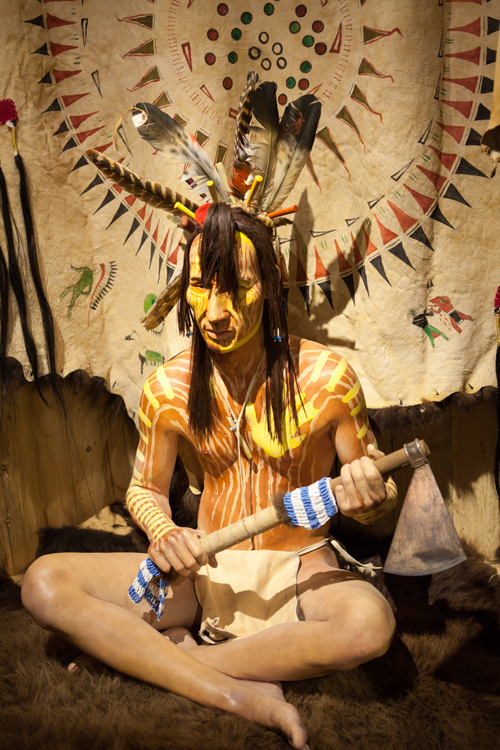Clark leads a party to visit Posecopsahe (Black Cat), the main chief at Ruptáre, one of the five Knife River Villages. Posecopsahe wishes for peace and returns two beaver traps recently stolen from two French traders. Pvt. Whitehouse describes Plains Village garden culture, and Lewis writes a letter to Charles Chaboillez—the North West Company bourgeois at Fort Assiniboine.
Mandan Warrior
From the Prince Maximilian and Karl Bodmer (1809–1893) Exhibit at the Lewis & Clark Interpretive Center, North Dakota. Photo 2011 by Kristopher K. Townsend.
Black Cat’s Speech
I believe what you have told us in Council, & that peace will be general, which not only givs me pleasure, but Satisfaction to all the nation, they now Can hunt without fear, and our womin Can work in the fields without looking every moment for the enimey—”
—William Clark
Dancing for Big White (Sheheke)
Soon after those Chiefs left us the Grand Chief of the Mandans Came Dressed in the Clothes we had given with his 2 Small Suns, and requested to See the men Dance which they verry readily gratified him in
—William Clark
Plains Village Horticulture
The Men that went with Captain Clark found among the Indians at this Village, Corn, Beans, Simlins, and many kind of Garden Vegetables, They & the Rick a Ree [Arikara] nation are the only Indians that we saw that cultivated the Earth, that reside on the Mesouri River.—
—Joseph Whitehouse
Letter to the North West Company
Upper Mandane Village, Oct. 31, 1804.
To Charles Chaboiller [Charles Chaboillez], Esq. of the N.W. Co.
We have been commissioned and sent by the government of the United States for the purpose of exploring the river Missouri, and the western parts of the continent of North America, with a view to the promotion of general science. Your government have been advised of the voyage and its objects, as the enclosed copy of a passport, granted by Mr. Edward Thornton, his Britannic Majesty’s charge d’affaires to the United States, will evidence.
MERIWETHER LEWIS. Capt. 1st U.S.R. Inf.
WILLIAM CLARK, Capt.[1]Donald Jackson, ed. Letters of the Lewis and Clark Expedition with Related Documents: 1783-1854, 2nd ed., (Urbana: University of Illinois Press, 1978), 213–214.
Weather Diary
Thermot. at rise
Weather Wind at rise
thermotr. at 4 P.M. Weather Wind at 4 oC P.M. 33 fair W 48 fair W. this day the Mandanes of the 2nd or upper vilage gave us an answer and some corn
—Meriwether Lewis[2]To assist the reader, the editor of this web page has omitted the “day of the month” column and spelled out some abbreviations.
Knife River Indian Villages National Historic Site is a High Potential Historic Site along the Lewis and Clark National Historic Trail managed by the U.S. National Park Service. A unit of the National Park System, the site is located at 564 County Road 37, one-half mile north of Stanton, North Dakota. It has exhibits, trails, and a visitor center.
Notes
| ↑1 | Donald Jackson, ed. Letters of the Lewis and Clark Expedition with Related Documents: 1783-1854, 2nd ed., (Urbana: University of Illinois Press, 1978), 213–214. |
|---|---|
| ↑2 | To assist the reader, the editor of this web page has omitted the “day of the month” column and spelled out some abbreviations. |
Experience the Lewis and Clark Trail
The Lewis and Clark Trail Experience—our sister site at lewisandclark.travel—connects the world to people and places on the Lewis and Clark Trail.
Discover More
- The Lewis and Clark Expedition: Day by Day by Gary E. Moulton (University of Nebraska Press, 2018). The story in prose, 14 May 1804–23 September 1806.
- The Lewis and Clark Journals: An American Epic of Discovery (abridged) by Gary E. Moulton (University of Nebraska Press, 2003). Selected journal excerpts, 14 May 1804–23 September 1806.
- The Lewis and Clark Journals. by Gary E. Moulton (University of Nebraska Press, 1983–2001). The complete story in 13 volumes.




